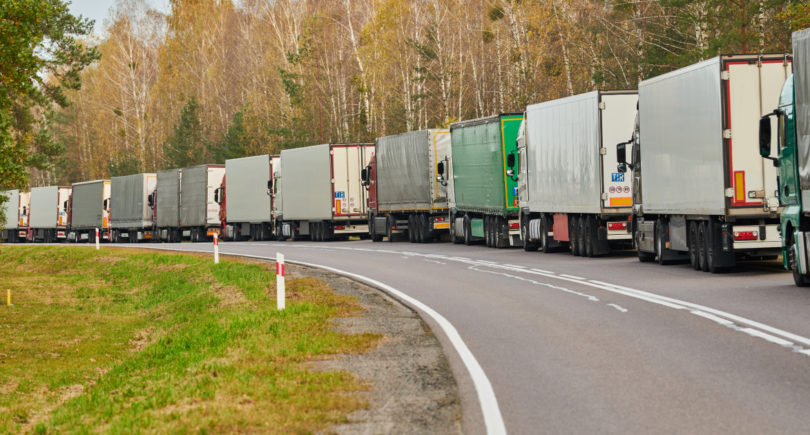
Opinions Infrastructure freight transportation 2006 03 February 2023
Due to problems with logistics last year, farmers and steel sector suffered the most
Russian aggression radically changed the freight base of railway logistics in Ukraine. In 2022, Ukrzaliznytsia (UZ) reduced freight transportation by more than half, and the largest specific weight of reductions fell precisely on the iron and steel cargo, fuel and energy complex (FEC) and construction. In particular, the volume of iron and manganese ores transportation fell from 77.6 million tons to 31.7 million tons, ferrous metals – from 21.7 million tons to 9.2 million tons, hard coal – from 50.2 million tons to 29.5 million tons, oil and oil products – from 12.4 million tons to 7 million tons, building materials – from 65.7 million tons to 22.8 million tons. The capacity of the agricultural sector somewhat softened the economic shocks for the railway caused by the war and the loss of a number of steel capacities. Compared to other cargo classes, the reduction in grain cargo transportation was the smallest and amounted to only 14.7% – 28.9 million tons in 2022 compared to 33.7 million tons in 2021.
A bet on agriculture
The agricultural sector remained the key sector that supported the economic capacity of railway logistics during the war. According to the conclusions of the Ministry of Agrarian Policy, infrastructure and logistics companies received a significant part of the margin from the export of agricultural crops in 2022. Agricultural producers paid UAH 4.244 billion to Ukrzaliznytsia in 2022 only for the use of the state fleet of grain railcars. This direction became the most profitable for the state transport operator in the year of the war, even surpassing the indicators of 2021 and 2020 (1.591 billion UAH and 0.506 billion UAH, respectively). This financial result that reflects the key problems of railway logistics and the shortcomings of Ukrzaliznytsia’s decisions during the war period. Against the backdrop of a reduction in the volume of transportation, UZ recognized the sale of grain railcars, rather than efficient transportation, as its main and priority task. This choice led to a series of missteps that led to a reduction in the supply of railcars and a further increase in demand and price for them. These include:
- unilateral refusal of the state infrastructure operator from the function of regulating and synchronizing flows;
- load restrictions on transitions were not implemented in a timely manner due to obvious and long-lasting signs of traffic jams;
- rejection of the main qualitative indicator of the carrier’s work – the speed and circulation of the railcar.
Ukrzaliznytsia stopped synchronizing the volume of loading with the volume of absorption and began to receive much more cargo than the throughput capacity of the western crossings could absorb. Artificially provoked queues at crossings caused a shortage of grain railcars and increased demand and prices for them. In order to avoid accusations, queues and traffic jams were forcibly scaled to other types of cargo. From time to time, UZ introduced and canceled load restrictions solely for the purpose of regulating the size of the queue and the number of cars of private fleets in it, in order to increase the demand and prices for its own cars and to dispose of the fleets in more profitable directions for itself (transportation to ports, as it was in November). The traffic jams clearly did not contribute to the freight work of foreign carriers and the absorption of all types of cargo by recipients in the EU countries. In addition, queues of railcars caused an increase in the costs of Ukrzaliznytsia for handling and sorting cargo, and an increase in the load on infrastructure and personnel.
The importance of planning
Ukrzaliznytsia made a lot of efforts to expand the carrying capacity of the western cross-border crossings. However, the state carrier did absolutely nothing to reduce queues and synchronize the crossing of transitions by exporters with foreign carriers, so that the Ukrainian side had an honest, unfeigned opportunity to demand the fulfillment of obligations from foreign carriers. In addition, due to the imperfect current planning technology, cargo owners cannot accurately know the terms and cost of the logistics of their cargo (this applies to both agricultural and other types of cargo). The shortcomings of planning are inevitably reflected in the transportation of non-agricultural products. After all, the resources of the UZ are diverted to service traffic jams, queues, and the extraction of goods necessary for a foreign carrier. The impossibility of planning cargo operations of EU enterprises (transshipment complexes, terminals), the lack of the possibility of connecting the schedules of non-agricultural cargo movement by EU railways lead to additional costs for foreign carriers and recipients of non-agricultural cargo. All this in the complex increases the cost of logistics and at the same time worsens the efficiency indicators of infrastructures and parks.
An obvious step in the conditions of war and the reorientation of logistics to the western borders should be the introduction of end-to-end and responsible planning of all processes and events related to cargo transportation. Such planning should be jointly carried out by Ukrzaliznytsia, neighboring European carriers, private fleet operators, European ports, as well as businesses of Ukraine and EU countries. All arguments regarding the impossibility of transparent long-term planning of cargo transportation are disproved by the innovations of UZ in passenger transportation, where there are both traffic schedules and the possibility of early online ordering. The real reason for the preservation of the outdated technology of freight transportation planning is the strategy chosen by the merchants of Ukrzaliznytsia to dispose of the surplus fleet of grain trucks in order to stimulate the deficit and increase their prices.
At the public level, only one component of the cost of railway logistics is discussed – the tariff, and the value of the railcar component is considered as derived from market relations. The increase in the transportation tariff by 70% (from $6.5 to $11 per ton) had objective reasons – an increase in the component costs of transportation. For grain worth $200/ton, this increase in price did not become critical. On the other hand, the railcar component increased during the year from UAH 2,000 to UAH 14,600 per day, and this did not happen for objective reasons, but as a result of the actions of Ukrzaliznytsia with the aim of maximizing revenues. And the current rules and policies affect not only the agricultural sector – cargoes of steelmakers are also stuck in traffic jams.
The agricultural sector and other businesses demand first of all cancel preferences for Ukrzaliznytsia railcars and ensure equal access to the railway infrastructure of all operators, both state and private, and all consignors: forwarders, traders, and producers. Give exporters an honest, non-feigned opportunity to synchronize crossings with foreign carriers and require them to comply, return to delivery time commitments, change the procedure for collecting/paying penalties for delivery time violations without going to court – and there will be no need to look for mechanisms to save the agricultural industry from bankruptcy.
Problem solving
A solution to the problem is possible, it depends on the management decisions of the government and Ukrzaliznytsia. Among the priorities should be an honest analysis of the cause-and-effect relationships that led to the increase in the cost of logistics with the simultaneous deterioration of the efficiency indicators of infrastructures and parks, and a change in the model of relations between shippers and providers of transportation services. First of all, the UZ should return to its main purpose – ensuring the functioning of the state’s economy. When in the conditions of war the railway, as the main circulatory system of the economy, makes it impossible to plan logistics and understand how much it will cost, it certainly does not contribute to the economic capacity of the state. Right now is the time to radically change priorities, values and principles of relationships. In a healthy economic system, all processes and events should revolve around producers, not economic players serving the producers’ need for access to sales markets. The strategic goal should be to achieve such a state of relations between production, trade and logistics that encourages the main driver of this system, the producer, to continue its economic activity – to produce products!
Ukrzaliznytsia should return to the criteria for the success of a healthy carrier – the increase in the turnover of railcars and the ability to deliver cargo and return empty goods in the shortest possible time. The total number of trips made by 7,000 railcars of the state carrier during 2022 testifies to the disappointing fact that the highest revenues were due to the lowest efficiency of the carrier. Ukrzaliznytsia grain carrier makes only 15 flights per year, while an efficient private owner should have 36 flights per year for responsible work and delivery deadlines. And if the agrarians paid UAH 4.244 billion to Ukrzaliznytsia, but for 36 railcars trips per year, it would be a different matter.
The commercial department of Ukrzaliznytsia voiced theses that producers should come to terms with the high cost of logistics, which is caused by the disproportion between agricultural demand for exports in the amount of 50 million tons/year and the capacity to absorb cargo, which since the beginning of the war due to the blockade of the Black Sea ports has narrowed to 20-30 million tons.
In my opinion, the solution to the problem lies in another plane. All railcar owners and cargo owners should first of all come to terms with the limited throughput capacity and realize: the export throughput capacity will not increase from loading larger volumes and raising transportation prices! It was necessary to recognize this as a priority and at the same time to make it clear to the exporters: if you cannot pass today, you will be able to tomorrow, the day after tomorrow, in a month. Ukrzaliznytsia should give businesses the opportunity to plan their events for a longer horizon than 30 days, so that highly organized market participants can plan transportation in advance, so that civilized conditions of forward export operations are available to them.
Transportation planning must clearly correspond to the bottleneck of logistics: it does not matter whether it is the capacity of ports or the total capacity of transitions. Then the owners of all cargoes will find their doors open – but without buying expensive railcars, without disposing of fleets in queues, without encouraging the inefficiency of Ukrzaliznytsia.
Last year, the government allocated UAH 10 billion to support the liquidity of UZ. This year, the state railway operator plans to allocate UAH 1.7 billion from the state budget. Invariance of the current rules and policies of Ukrzaliznytsia will mean that taxpayers’ money (which is paid by UZ’s competitors and those who do not use the railway) will continue to support inefficient activities that do not contribute to production and exports.
The effective work of Ukrzaliznytsia as a state monopolist can only be influenced by the common sense of state-minded officials. On the condition that those in power will be influenced by their employers – taxpayers from the real sector of the economy, producers from the agro-industrial complex, steel and other industries. Provided, of course, that they understand the cause-and-effect relationships between the deterioration of export conditions and the actions of the state monopolist.





